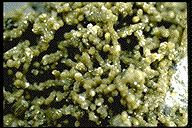 THE
MINERAL CORDYLITE-(Ce)
THE
MINERAL CORDYLITE-(Ce)
 THE
MINERAL CORDYLITE-(Ce)
THE
MINERAL CORDYLITE-(Ce)- Chemistry: Ba(Ce, La)2(CO3)3F2 , Barium Cerium Lanthanum Carbonate Fluoride.
- Class: Carbonates
- Groups: Rare earth carbonates and Bastnasite.
- Uses: As a very minor ore of cerium and other rare earth metals and as mineral specimens.
Specimens
Cordylite belongs to the rare earth carbonates, an informal and relatively rare group of minerals.
Some of the other more common rare earth carbonates are
Cordylite was first discovered at the famous mineral site of
Cordylite is found in carbonatites, alkaline syenites and zeolite veins. It is a rare mineral as it is known from only a few localities and then not in large amounts.
PHYSICAL CHARACTERISTICS:
- Color is colorless, yellow, brownish-yellow and orange-yellow.
- Luster is greasy to adamantine.
- Transparency: Crystals are translucent to transparent, some specimens approach opaqueness.
- Crystal System is hexagonal.
- Crystal Habits include small prismatic or platy crystals, some demonstrating a hemimorphic character.
- Cleavage is good in one direction (basal).
- Fracture is conchoidal.
- Hardness is typically around 4.5
- Specific Gravity is approximately 4.0 to 4.3 (well above average)
- Streak is white.
- Other Characteristics: Crystals can show some striations parallel to the basal face.
- Associated Minerals include
bastnasite,
calcite,
aegirine,
albite,
quartz,
ashcroftine-(Y) , brookite, burbankite, carbocernaite, synchysite-(Ce), ankerite,ancylite-(Ce) ,mckelveyite , elpidite, narsarsukite, lorenzenite,leucosphenite and several zeolites. - Notable Occurrences include the type locality of
Narsarsuk , Greenland. Other localities include the mines of Mont Saint-Hilaire, Quebec and Kibina, Kola Peninsula, Russia. - Best Field Indicators: are crystal habit, color, cleavage, density, luster and locality.








